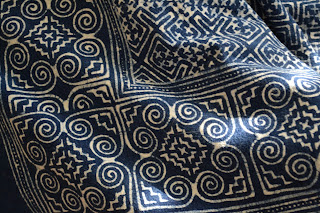 The Russian Market in Phnom Penh is labyrinthine maze where I'm pretty sure you could buy literally anything you needed - from a new hose pipe or used stereo to your weekly grocery shop and designer clothes (made during an illegal third shift at one of Cambodia's many textile factories).
The Russian Market in Phnom Penh is labyrinthine maze where I'm pretty sure you could buy literally anything you needed - from a new hose pipe or used stereo to your weekly grocery shop and designer clothes (made during an illegal third shift at one of Cambodia's many textile factories). The weekend market in Kuching is a wonderful outdoor affair (particularly if it isn't raining) where you can buy fresh green peppercorns for a few cents - it also has the most impressive range of fresh and dried chilis that I've ever seen.
Vientiane has lovely markets too, entire warehouse sized rooms that are literally overflowing with leafy greens, herbs, rice, onions, ginger, and coffee. Beyond food, you can buy large bundles of silk, handwoven longyi, scarves, quilts and more. Prices are so low as to almost be offensive.
 Solo in Indonesia has a terrific antiques market that is full to bursting with local handicrafts such as shadow puppets, Javanese-style masks and clay tea sets. Not to forget the amazing selection of Indonesian coffees - I think we came home with two kilos of beans.
Solo in Indonesia has a terrific antiques market that is full to bursting with local handicrafts such as shadow puppets, Javanese-style masks and clay tea sets. Not to forget the amazing selection of Indonesian coffees - I think we came home with two kilos of beans.However, the overwhelming winner in this category is the weekend walking market in Chiang Mai, Thailand.
Late afternoon on every Saturday and Sunday the
centre of this city of 160,000 people is pedestrianised and out come the vendors. The entire city centre is transformed into a huge market covering several square blocks. Locals and tourists alike ply the streets in search of a bargain - clothes, scarves, old jewelry, new jewelry, paintings, sketches, trinkets, textiles you name it.
Forming part of Northern Thailand's 'Golden Triangle' Chiang Mai is a hub for many indigenous tribes to come and sell their goods. Perhaps the most well-known group is the Hmong People (who are spread over the mountainous border areas of Thailand, China, Vietnam and Laos). The Hmong played a significant role in (unsuccessfully) fighting the Communists in Laos in the 1970s - many received asylum in the US where they have formed small Diasporas - particularly in Minnesota and Northern California.

I digress. Hmong culture in Northern Thailand appears to be alive and well and they produce some truly stunning products. I swore that Chiang Mai was not going to be a shopping expedition, but how could I pass up this beautiful bedspread - painstakingly hand-dyed with blocks? $60 well spent, methinks.
Oh, and there is food. Lots and lots of really, really good food.




